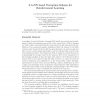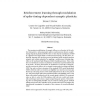44 search results - page 4 / 9 » Robot reinforcement learning using EEG-based reward signals |
NECO
2007
13 years 6 months ago
2007
Learning agents, whether natural or artificial, must update their internal parameters in order to improve their behavior over time. In reinforcement learning, this plasticity is ...
EUROCAST
2007
Springer
14 years 26 days ago
2007
Springer
Abstract a paradigm of modern Machine Learning (ML) which uses rewards and punishments to guide the learning process. One of the central ideas of RL is learning by “direct-online...
NECO
2007
13 years 6 months ago
2007
The persistent modification of synaptic efficacy as a function of the relative timing of pre- and postsynaptic spikes is a phenomenon known as spiketiming-dependent plasticity (...
IROS
2009
IEEE
14 years 1 months ago
2009
IEEE
—This study attempts to make a compact humanoid robot acquire a giant-swing motion without any robotic models by using reinforcement learning; only the interaction with environme...
ICRA
2009
IEEE
14 years 1 months ago
2009
IEEE
Abstract— Least-squares policy iteration is a useful reinforcement learning method in robotics due to its computational efficiency. However, it tends to be sensitive to outliers...


